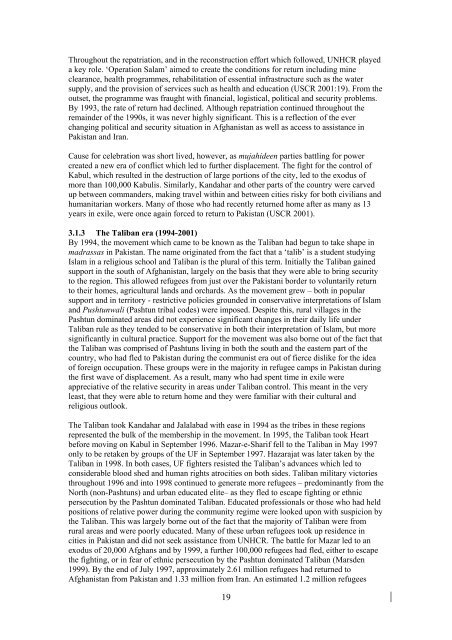Afghanistan. - Forced Migration Online
Afghanistan. - Forced Migration Online
Afghanistan. - Forced Migration Online
Create successful ePaper yourself
Turn your PDF publications into a flip-book with our unique Google optimized e-Paper software.
Throughout the repatriation, and in the reconstruction effort which followed, UNHCR played<br />
a key role. ‘Operation Salam’ aimed to create the conditions for return including mine<br />
clearance, health programmes, rehabilitation of essential infrastructure such as the water<br />
supply, and the provision of services such as health and education (USCR 2001:19). From the<br />
outset, the programme was fraught with financial, logistical, political and security problems.<br />
By 1993, the rate of return had declined. Although repatriation continued throughout the<br />
remainder of the 1990s, it was never highly significant. This is a reflection of the ever<br />
changing political and security situation in <strong>Afghanistan</strong> as well as access to assistance in<br />
Pakistan and Iran.<br />
Cause for celebration was short lived, however, as mujahideen parties battling for power<br />
created a new era of conflict which led to further displacement. The fight for the control of<br />
Kabul, which resulted in the destruction of large portions of the city, led to the exodus of<br />
more than 100,000 Kabulis. Similarly, Kandahar and other parts of the country were carved<br />
up between commanders, making travel within and between cities risky for both civilians and<br />
humanitarian workers. Many of those who had recently returned home after as many as 13<br />
years in exile, were once again forced to return to Pakistan (USCR 2001).<br />
3.1.3 The Taliban era (1994-2001)<br />
By 1994, the movement which came to be known as the Taliban had begun to take shape in<br />
madrassas in Pakistan. The name originated from the fact that a ‘talib’ is a student studying<br />
Islam in a religious school and Taliban is the plural of this term. Initially the Taliban gained<br />
support in the south of <strong>Afghanistan</strong>, largely on the basis that they were able to bring security<br />
to the region. This allowed refugees from just over the Pakistani border to voluntarily return<br />
to their homes, agricultural lands and orchards. As the movement grew – both in popular<br />
support and in territory - restrictive policies grounded in conservative interpretations of Islam<br />
and Pushtunwali (Pashtun tribal codes) were imposed. Despite this, rural villages in the<br />
Pashtun dominated areas did not experience significant changes in their daily life under<br />
Taliban rule as they tended to be conservative in both their interpretation of Islam, but more<br />
significantly in cultural practice. Support for the movement was also borne out of the fact that<br />
the Taliban was comprised of Pashtuns living in both the south and the eastern part of the<br />
country, who had fled to Pakistan during the communist era out of fierce dislike for the idea<br />
of foreign occupation. These groups were in the majority in refugee camps in Pakistan during<br />
the first wave of displacement. As a result, many who had spent time in exile were<br />
appreciative of the relative security in areas under Taliban control. This meant in the very<br />
least, that they were able to return home and they were familiar with their cultural and<br />
religious outlook.<br />
The Taliban took Kandahar and Jalalabad with ease in 1994 as the tribes in these regions<br />
represented the bulk of the membership in the movement. In 1995, the Taliban took Heart<br />
before moving on Kabul in September 1996. Mazar-e-Sharif fell to the Taliban in May 1997<br />
only to be retaken by groups of the UF in September 1997. Hazarajat was later taken by the<br />
Taliban in 1998. In both cases, UF fighters resisted the Taliban’s advances which led to<br />
considerable blood shed and human rights atrocities on both sides. Taliban military victories<br />
throughout 1996 and into 1998 continued to generate more refugees – predominantly from the<br />
North (non-Pashtuns) and urban educated elite– as they fled to escape fighting or ethnic<br />
persecution by the Pashtun dominated Taliban. Educated professionals or those who had held<br />
positions of relative power during the community regime were looked upon with suspicion by<br />
the Taliban. This was largely borne out of the fact that the majority of Taliban were from<br />
rural areas and were poorly educated. Many of these urban refugees took up residence in<br />
cities in Pakistan and did not seek assistance from UNHCR. The battle for Mazar led to an<br />
exodus of 20,000 Afghans and by 1999, a further 100,000 refugees had fled, either to escape<br />
the fighting, or in fear of ethnic persecution by the Pashtun dominated Taliban (Marsden<br />
1999). By the end of July 1997, approximately 2.61 million refugees had returned to<br />
<strong>Afghanistan</strong> from Pakistan and 1.33 million from Iran. An estimated 1.2 million refugees<br />
19
















